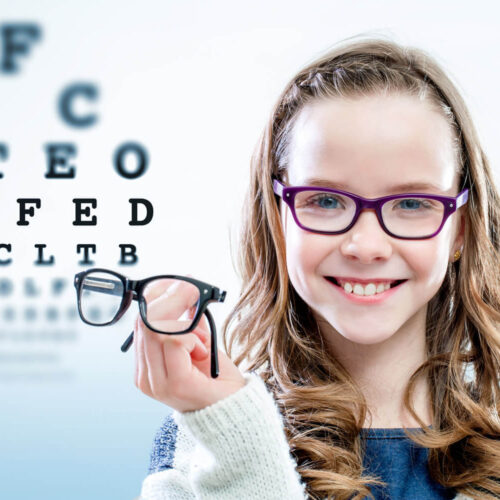PEDIATRIC EYE CARE
It is important to have children’s eye health checked early. This helps to rule out disease and lazy eye. Early treatment for lazy eye or amblyopia can be instituted the better is the outcome. As the child matures, the more refined and detailed the exam becomes. Having properly corrected lenses, if needed, is also crucial to school-age children and their ability to concentrate in class. Learn more below about the importance of pediatric eye care.
Vision problems in children and adolescents can cause difficulty with learning, communicating, social activities, and sports. Left untreated, vision problems can become more difficult to correct. Improving the eye health of children and adolescents goes beyond just preventing visual impairment.”
– The National Institutes of Health (NIH)

Common Vision Problems Symptoms
Not sure if your child has vision problems? Here are some early signs they might need to have an eye exam:
- Loses place while reading
- Holds reading material close
- Tends to rub their eyes
- Complains of frequent headaches
- Turns or tilts head to use one eye only
- Uses finger when reading
- Confuses small words when reading
- Performs below potential
- Difficulty in learning word recognition
When should my child have an eye exam?
Dr. Teles examines infants and children at any age. Newborns and high-risk newborns are generally checked by a pediatrician or other eye specialist in the hospital nursery. During the infant’s first year a more thorough screening is usually performed on a visit to the pediatrician or an eye doctor with experience in examining young children.
Anytime there is any vision or eye concern prior to age three an exam should be scheduled. By age 2 ½ to 3 ½, all children should have a routine professional comprehensive eye health, vision and vision development examination. After the initial examination, your doctor will discuss the frequency of return visits based on risk factors. This could range from six months to two years. Screenings by pediatricians or schools are not a substitute for a professional eye exam.
Approximately 75,000 3-year olds have or develop amblyopia each year. Before the age of 5, treatment is critical. Unfortunately, only half of all kids after the age of 5 are diagnosed.
Vision disorders are the 4th most common disability in the U.S. and the leading cause of handicapping conditions in children.”
– American Academy of Optometry (AAO)
The basic vision skills needed for school-age children:
- Near Vision: The ability to see clearly and comfortably at 10-13 inches.
- Distance Vision: The ability to see clearly and comfortably beyond arm’s reach.
- Eye Movement Skills: The ability to aim the eyes accurately, move them smoothly across a page and shift them quickly and accurately from one object to another.
- Focusing Skills: The ability to keep both eyes accurately focused at the proper distance to see clearly and to change focus quickly.
- Peripheral Awareness: The ability to be aware of things located to the side while looking straight ahead.
- Form Perception Skills: The ability to discriminate basic shapes.
- Binocular Coordination: The ability to use both eyes together.
- Visual-Motor Skills: The ability to reproduce basic shapes with pencil and paper.
- Eye-hand Coordination: The ability to use the eyes and hands together.
Don’t wait to have your child’s eye exam scheduled. Also, check out our blog for more commonly asked questions.
PEDIATRIC EYE CARE IS ESSENTIAL
It’s not just about the health of children’s eyes, which is important in itself. Not having a proper eye exam can prevent them from reaching their full potential.

